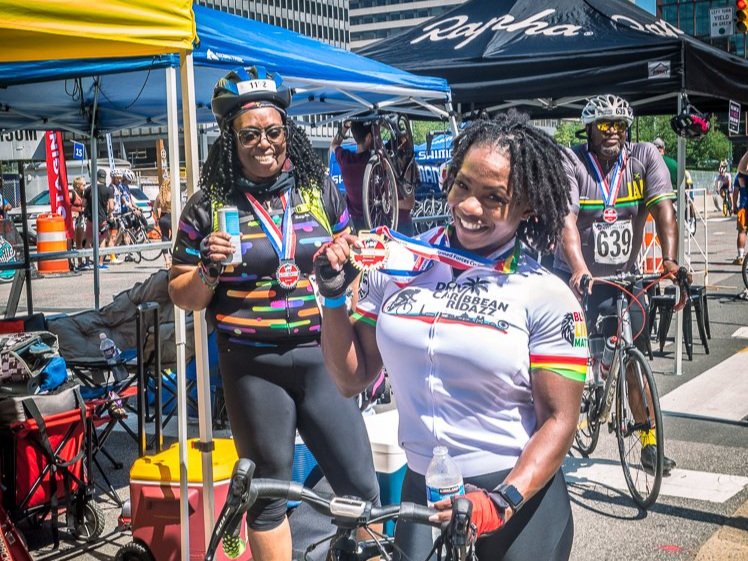Important Ride Etiquette!
Since the Challenge Ride began in 2008, our goal is to create an inclusive cycling event that inspires everyone who participates. Cyclists of all abilities have been challenging themselves since the first year. We want to see the novice rider get inspired by the more experienced rider.
By being inclusive, we can bring the full cycling community together to celebrate our sport and all the wonderful things things we enjoy about it!
Racers: Those who have raced, or carry a USA Cycling racing license, we hope you will come out to challenge yourself, but also recognize that you can inspire others with less experience. We want to grow our community, so be aware are respectful and setting a great example on how to ride safely in a large group. Be polite and patient.
Novice riders, we know that large groups of cyclist riding at higher speeds can be intimidating and a little scary. Following some simple rules will ensure everyone will enjoy their experience:
- Slower riders stay to the right
- Announce yourself when passing slower riders, when appropriate
- Slow down in designated areas
- ALWAYS EXIT THE COURSE ON YOUR RIGHT!
- NEVER U-TURN ON THE COURSE!
SAFETY IS ESSENTIAL!
We care, so we want you to care too!
To ensure you have the best riding EXPERIENCE.
· Plan on consuming at least one water bottle every 20 miles to stay hydrated. If you carry two water bottles, you should be able to complete 6 laps with just one extra bottle. For 9 laps, plan on 3-4 bottles. Best to have an extra bottle or two ready, either in a safe location, or with a friend. Corporate Challenge Teams can use their Tents (just be careful if slowing down to pick-up a bottle and returning to the ride, look before you re-enter.)
· We will have over 20 Ride Ambassadors out on the course, helping you with minor mechanical issues and can assist in contacting medical support, if needed. We will also plan to have a number of Moto Refs out on the course helping to notify lapped riders of the faster riders coming up. They will also be assisting in assuring riders are being safe and considerate.
· We will also be introducing a team of Ride Deputies, who will be helping to support our overall goal of safety and enjoyment. They will be out helping to reinforce good manners and group ride practices.
But, what can you do? First let’s start with the non-negotiables:
· PROTECT YOUR HEAD: Helmets with chin straps fastened must be worn at ALL TIMES while riding during the event. No exceptions. Helmets meeting US DOT or CPSC standards are required.
· SLOW DOWN IN DESIGNATED AREAS: To ensure safety, we ask that you check your speed in three designated “NO WAKE” zones. These zones are where there will be the most mixing of abilities, so it’s best to just ride safely through them. It will have MINIMAL effect on your overall time.
· Leading into and out of the U-Turn in Roslyn
· Down the off-ramp off of RTE 110 and the left-hand turn onto 15th ST S
· Through the S/F line on 12th ST South, between Long Bridge Drive and S Eads (turn one)
· The rest of the route has plenty of room for slower riders to stay to the right, with faster riders/groups safely passing on the left.
As a rider, there are basic courtesies you can observe to protect yourself and those around you.
KNOW WHO’S AROUND YOU: Be conscious of other cyclists around you. In a large group ride, riders behind you will not be prepared for you to stop or swerve suddenly, so if you have an emergency, be sure to pull safely off the road and out of the way of other cyclists before coming to a stop. When starting again, check carefully for traffic and yield slowly onto the road.
USE SIGNALS: Use standard hand signals to indicate turning or stopping. Calling out your intended movements to other cyclists is also helpful. Left Turn: left arm straight out | Stop: left arm bent downward with elbow at 90-degree angle | Right Turn: left arm bent upward with elbow at 90-degree angle.
LOOK OUT FOR YOURSELF: You are responsible for getting yourself safely through an intersection, even if you are in a group. Especially in larger groups, traffic situations may change as the group continues to cross, so make a safe decision when you get to the intersection.
COMMUNICATE WITH OTHERS: Warn cyclists behind you of possible dangers in the road, including potholes, debris, glass, speed bumps, etc. Be alert for faster riders coming behind you. If you are in the front of a group, warn riders behind you of approaching slower groups by calling “riders up!” clearly behind you. If you are in the back of a group, warn the cyclists ahead of you of faster riders approaching from the rear by calling “riders back!”
BE COURTEOUS: Slower cyclists should stay closest to the right edge of the road to allow room for faster cyclists to pass easily to the left. If you are trying to pass someone, politely call out “On your left!” before passing to make them aware. If you have a bell on your bike, this is helpful as well to notify cyclists ahead of you. When riding on narrow roads and up climbs, leave gaps in between cyclists for cars to pass safely.
AND DON’T FORGET ABOUT NUTRITION & HYDRATION! Hydration is key, but chugging a gallon of water 30 minutes before the event is not the right way to hydrate! The morning of the event, drink water several hours before the start to give your body time to absorb it and flush out your system.



